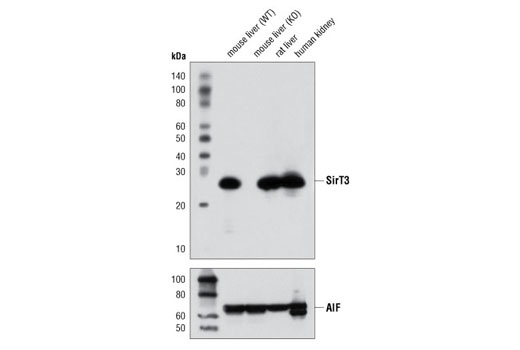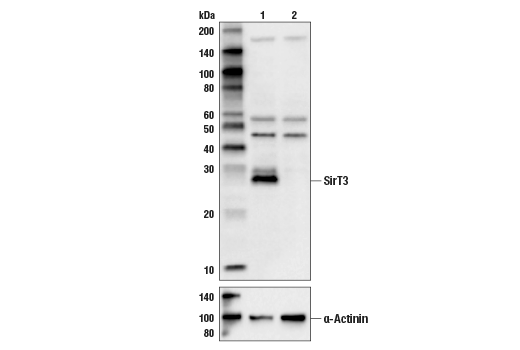WB, IP
H M R
Endogenous
28
Rabbit IgG
#Q8R104
64384
Product Information
Product Usage Information
| Application | Dilution |
|---|---|
| Western Blotting | 1:1000 |
| Immunoprecipitation | 1:100 |
Storage
Specificity / Sensitivity
Species Reactivity:
Human, Mouse, Rat
Source / Purification
Monoclonal antibody is produced by immunizing animals with a synthetic peptide corresponding to residues surrounding Val130 of mouse SirT3 isoform S.
Background
The Silent Information Regulator (SIR2) family of genes is a highly conserved group of genes that encode nicotinamide adenine dinucleotide (NAD)-dependent protein deacetylases, also known as Class III histone deacetylases. The first discovered and best characterized of these genes is Saccharomyces cerevisiae Sir2, which is involved in silencing of mating type loci, telomere maintenance, DNA damage response and cell aging (1). SirT3, a mammalian homolog of Sir2, exists in human cells in two forms. The full-length 44 kDa protein localizes to the nucleus, while a processed 28 kDa protein lacking 142 amino terminal residues localizes exclusively to the mitochondria (2-4). The single murine form of SirT3 is equivalent to the processed human SirT3 protein (2). Full-length SirT3 protein is processed in the mitochondrial matrix by the mitochondrial matrix processing peptidase (MMP) (3). Both full-length and processed forms of SirT3 are enzymatically active and de-acetylate histone H3 at Lys9 and histone H4 at Lys16 in vitro (2). SirT3 also de-acetylates Lys642 of acetyl-CoA synthetase 2 (AceCS2) and activates AceCS2 activity in the mitochondria (5). Restricted caloric intake, which is linked to increased lifespan in multiple organisms, increases SirT3 expression in white and brown adipocytes of obese mice, suggesting a role for SirT3 in aging (6). Two observations implicate SirT3 in the regulation of mitochondrial thermogenesis. First, exposure to cold temperatures increases SirT3 expression in brown adipocytes, while elevated temperatures reduce SirT3 expression (6). Second, over-expression of SirT3 results in increased levels of the mitochondrial uncoupling protein 1 (UCP1) (6). SirT3 protein levels are also elevated in certain breast cancers (7).
- Guarente, L. (1999) Nat Genet 23, 281-5.
- Scher, M.B. et al. (2007) Genes Dev 21, 920-8.
- Schwer, B. et al. (2002) J Cell Biol 158, 647-57.
- Onyango, P. et al. (2002) Proc Natl Acad Sci USA 99, 13653-8.
- Schwer, B. et al. (2006) Proc Natl Acad Sci USA 103, 10224-9.
- Shi, T. et al. (2005) J Biol Chem 280, 13560-7.
- Ashraf, N. et al. (2006) Br J Cancer 95, 1056-61.
Species Reactivity
Species reactivity is determined by testing in at least one approved application (e.g., western blot).
Western Blot Buffer
IMPORTANT: For western blots, incubate membrane with diluted primary antibody in 5% w/v BSA, 1X TBS, 0.1% Tween® 20 at 4°C with gentle shaking, overnight.
Applications Key
WB: Western Blotting IP: Immunoprecipitation
Cross-Reactivity Key
H: human M: mouse R: rat Hm: hamster Mk: monkey Vir: virus Mi: mink C: chicken Dm: D. melanogaster X: Xenopus Z: zebrafish B: bovine Dg: dog Pg: pig Sc: S. cerevisiae Ce: C. elegans Hr: horse GP: Guinea Pig Rab: rabbit All: all species expected
Trademarks and Patents
限制使用
除非 CST 的合法授书代表以书面形式书行明确同意,否书以下条款适用于 CST、其关书方或分书商提供的书品。 任何书充本条款或与本条款不同的客书条款和条件,除非书 CST 的合法授书代表以书面形式书独接受, 否书均被拒书,并且无效。
专品专有“专供研究使用”的专专或专似的专专声明, 且未专得美国食品和专品管理局或其他外国或国内专管机专专专任何用途的批准、准专或专可。客专不得将任何专品用于任何专断或治专目的, 或以任何不符合专专声明的方式使用专品。CST 专售或专可的专品提供专作专最专用专的客专,且专用于研专用途。将专品用于专断、专防或治专目的, 或专专售(专独或作专专成)或其他商专目的而专专专品,均需要 CST 的专独专可。客专:(a) 不得专独或与其他材料专合向任何第三方出售、专可、 出借、捐专或以其他方式专专或提供任何专品,或使用专品制造任何商专专品,(b) 不得复制、修改、逆向工程、反专专、 反专专专品或以其他方式专专专专专品的基专专专或技专,或使用专品开专任何与 CST 的专品或服专专争的专品或服专, (c) 不得更改或专除专品上的任何商专、商品名称、徽专、专利或版专声明或专专,(d) 只能根据 CST 的专品专售条款和任何适用文档使用专品, (e) 专遵守客专与专品一起使用的任何第三方专品或服专的任何专可、服专条款或专似专专


